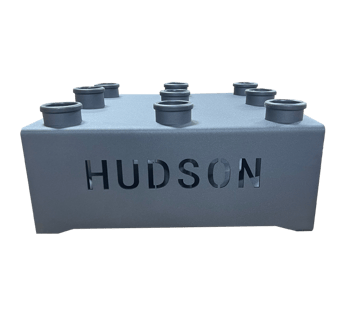Maintaining Your Investment---Your Olympic Bar!
There are huge differences in the quality and specialization of olympic bars. There is a reasons we sell versions from $150 to $1600. We've gone over that before here.
But, barbell maintenance is something a lot of people tend to overlook. Especially after spending money on a good barbell, the last thing you want is for them to rust or for the bearings to slow. Or for them to bend due to poor storage.
To prolong the life of your barbell it is important that you regularly clean it. Regular maintenance allows the bar to continue to perform at its optimum level for longer.
How regularly this has to occur depends on the climate it is kept in and how regularly the barbells are used. For example, a busy gym in a hot, or especially a moist, climate may have to carry out preventative maintenance more frequently a lot more frequently!
Humidity is a killer here, obviously.
Commercial Gyms
If your bar/s are used in commercial gym setting, I certainly hope the barbells use is going to be a lot higher than that of a residential use. This makes it much more beneficial, as well as profitable, to maintain the Barbell on schedule. Regardless of the finish on the bar, we recommend a fortnightly, or at minimum monthly maintenance clean and check.
Home Gyms
As for the home gym owners, the bar will most likely not need to be cleaned as regularly to that of a commercial gym, depending on the usage of course. For bars that are Cerakote, Stainless Steel or Hard Chrome, you can normally elongate the periods without cleaning them, however, you will still have to regularly lubricate the bushings and bearings if you want the sleeves to spin freely. For bars that are bare steel, black Oxide or zinc, complete maintenance should be performed fortnightly, or monthly at a minimum.
Rust is the main issue we want to combat. People sweat and steel rusts; combine the two and you end up with a rusty bar. Most manufacturers will attempt to overcome this by coating the bar with black oxide, chrome or zinc, however, you still need to maintain your bar. There is no such thing as a maintence-free bar.
Here's what you should need
1. Stiff nylon bristle brush
2. 3 in 1 oil /WD40/Mineral oil
3. Some sort of rag to use with the oil, and another one for removing it.
Basics!
1. Clean The Chalk Out of the Knurling
The optimum situation is cleaning the chalk out of the knurling on a daily basis or after every use. Chalk really eats away at the knurling and surface coating of the bar. To do this just use a stiff nylon bristle brush back and forth along the knurling of the bar until the chalk is gone.
The reason it is important is that you use the chalk for absorbing the moisture on your hands and creating a more sure grip. Therefore, when left on the bar, the chalk is absorbing any humidity and holds it on the steel, creating more rust.
2. Wipe Down the Bar
Wiping down your barbell is a simple way to maintain the bar and get longer use out of it. How often you need to do this will vary depending on use and the facility, as we've mentioned.
This part of the procedure should be performed directly after the brushing of the bar, if possible. Use a light coat 3-in-1 oil, or mineral oil. Spray it onto the oil rag, wipe down the whole bar and leave overnight, then wipe it down again with a to clean the oil off.
This is Ivan's (from Ivanko) recommendation for his Black Oxide bars.
The Black-oxide finish on your bar is quality coating but is not a rust-preventative. If neglected, your bar will do what steel does best: it will rust. You can wipe your bar down with a rag sprayed with WD-40.
If need be, you can clean the chalk from the knurling with a synthetic bristle brush from a hardware store. Do not spray WD-40 into the sleeves of the bar. Your sleeves are oiled with SAE-20 weight non-detergent oil. This oil is ideal, but 3-in-1 oil works too. WD-40 oil = mush. If need be, you can lubricate the sleeves once a month with a drop of SAE-20 (non-detergent) in the hole of the end cap and where the sleeve-collar meets the bar. Some will tip the bar on one end, apply oil on the sleeve (and the opposed) sleeve-collar end, wait a few hours and then repeat the process for the other side. This insures that the oil really works its way into the sleeve assembly.
3. Check the Sleeve of the Barbell
Most bars have oil-impregnated bearings or bushings, which are sealed and therefore you cannot oil them. Some bars now have small oil holes in the sleeves, allowing you to drop oil (not WD-40, see Ivan's note above) into them, this allows the sleeves to spin more freely. Aim to do this at the same time as your other maintenance and make sure you wipe away any excess that may have leaked from the sleeve. Especially at a commercial or light-commercial space, this is all about liability.
Barbell Storage
How you store your barbells also can affect longevity.
Start by stripping your bar of all the weights. I know, at home,you like to leave the weights on, but it is aging your bar unnecessarily. Bars are designed to hold plate only during lifts, but not permanently. If you leave plates on our bar, the bar can bend. And even a little bit is enough to start the process. And this is one of those places that poorer quality bars start aging a LOT faster.
A barbell can be stored horizontally on a rack (unloaded of course), on a wall frame in a horizontal position. There are also vertical storage racks and options, that save some space. It is slightly better to store the bars in the horizontal position, in terms of the oil in the sleeves.
Let us know if you have any further questions, about the specific maintence a manufacturer has given, or if you have any other questions whatsovever.





%20CORRECT%20FOOTER%20PIC.png?width=500&height=333&name=together%20(bottom%20slider)%20CORRECT%20FOOTER%20PIC.png)
COMMENTS